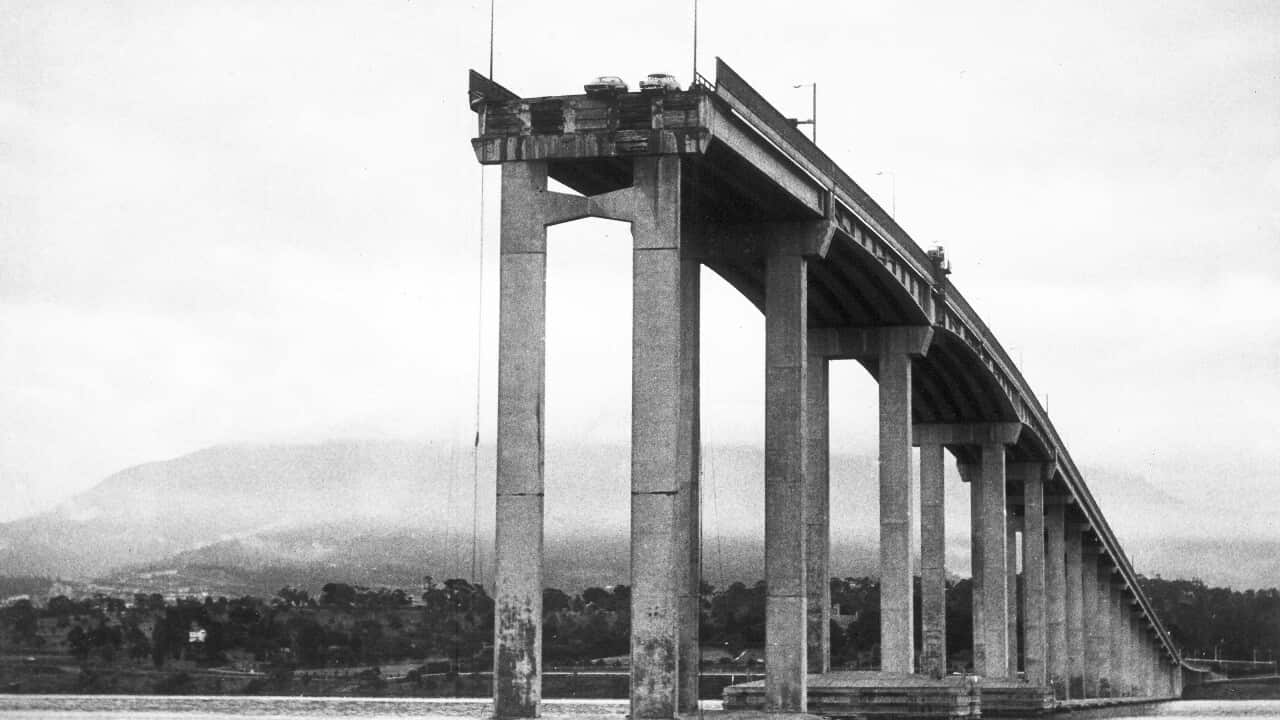Key Points
- Hobart's Tasman Bridge partially collapsed in 1975 after a bulk carrier crashed into it.
- Twelve people were killed, and the city was split in two.
- It took almost three years for the bridge to be repaired and reopen.
Almost 50 years before a container ship crashed into Francis Scott Key Bridge in the US city of Baltimore, causing its total collapse and the presumed loss of six lives, a similar tragedy struck Australia.
On the evening of Sunday 5 January 1975, bulk carrier Lake Illawarra was making its way up Hobart's Derwent River when it collided with the Tasman Bridge.
It caused two pylons and over 100 metres of road to collapse, leaving two cars teetering on the edge while four others plunged 45 metres into the cold depths below.
Twelve people were killed — seven of the ship's crew and five occupants of the cars that drove over the gap in the bridge.
Imogen Wegman, a history lecturer at the University of Tasmania, said the Tasman Bridge collapse had an "enormous", lasting effect on the city's residents.
"It was incredibly significant … the impact of it just reverberated through the area," she said.
"It was the second big disaster that Tasmania had experienced in about a decade; we'd had , and then eight years later, we have the Tasman Bridge go down."
The tragedy quite literally divided the city in two.
"The eastern shore was described at the time in some reports as a 'dormitory suburb' — that it didn't have a lot of the public infrastructure that was needed for it to survive independently," Wegman said.
"It didn't have as many schools, it didn't have government services … most people were reliant on getting into Hobart to go to the doctor, to get to the hospital, to get to the university, to get to theatres, to get to everything.
"Suddenly, they were cut off from that."

The partial bridge collapse left Hobart split in two. Credit: Tasmanian Archives and Heritage Office
They became a social institution, partly due to some of the boats being licensed to sell alcohol, and they even gave rise to a local hit song, The Ferry Boat Shuffle.
"The ferry queues, as tedious as they were, gave some catharsis and strangers had a common levelling field," Wegman said.
Around a year later, a temporary modular bridge was established between the eastern and western shores of the Derwent.
In October 1977, the two sides of the city were properly reunited when the reconstructed Tasman Bridge was finally reopened.

The Tasman Bridge collapse left the residents of Hobart's eastern shore reliant on ferries to get to the CBD. Credit: Libraries Tasmania/David H. Jones
Many Hobartians — even those who weren't born at the time — still get anxious about crossing the bridge, Wegman said.
"The Tasman Bridge is such a dominant part, such a statement of Hobart that I think that anybody who knows the story can always be reminded of it, especially when you see ships going through," she said.
Could something like this happen again in Australia?
Some "public good" did come out of the tragedy, Wegman said.
Beyond speeding up the development of Hobart's eastern shore and the establishment of a second permanent bridge further upriver, "much more rigorous" safety standards were introduced.
"The new [Antarctic] icebreaker has been refused permission to go under the bridge because so many of the computer simulations showed it crashing," Wegman said.

It took almost three years for the Tasman Bridge to be repaired and reopened. Credit: Libraries Tasmania
"I'm quite sure we're as protected as much as can be," he said.
"Obviously it was questionable back in 1975, I believe, but we learned our lesson."


